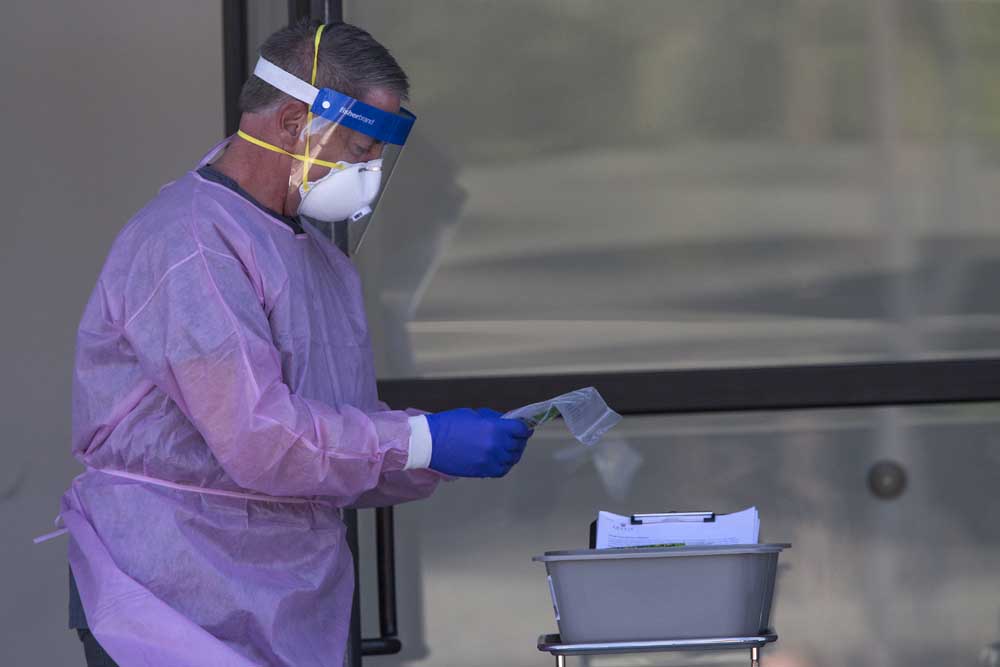Oregon may need 600 new contact tracers to reopen
Published 3:00 pm Friday, April 24, 2020

- Dan Cox, an urgent care paramedic, prepares to test a patient for COVID-19 last month in the parking lot of High Lakes Urgent Care in Bend.
Oregon health officials may need 600 more workers to perform coronavirus contact tracing under a plan being developed for Gov. Kate Brown’s “Reopening Oregon” framework.
The tracers would be largely tasked with performing time-consuming detective work to help slow the spread of coronavirus when Brown and counties begin lifting restrictions to restart sectors of the economy.
Brown expects to see a draft plan in the next couple of days for how many trackers the state must enlist to identify people exposed to known COVID-19 infections and then monitor them to make sure they get tested and follow quarantine guidelines.
Much remains unknown about the plan and how it would better protect Oregonians from coronavirus in the months ahead. State and public health officials attempted to perform contact tracing after the pandemic officially arrived Feb. 28 in Oregon but quickly became overwhelmed by the volume of new infections.
National health experts see increased testing to detect the coronavirus and thorough contact tracing as the country’s best bet to reopen shuttered businesses. In Oregon, Brown announced stay-at-home restrictions March 23.
The need for 600 tracers is the latest estimate in what has been a moving target for the past two weeks.
Brown’s chief of staff, Nik Blosser, said last week that Oregon would need between 100 to 150 tracers and possibly more.
But state Sen. Michael Dembrow, a Portland Democrat, wrote in a newsletter to constituents Monday that “over the next few weeks, around 600 people will be hired to take this questioning to the next level.” He apparently gleaned that number from Patrick Allen, director of the Oregon Health Authority, during a conference call earlier in the day.
Jonathan Modie, a spokesman for the health authority, confirmed in a statement the estimated need for workforce and training staff of “an estimated 600 additional personnel.” Those workers would perform contact tracing, specimen collection and help link people who are under isolation or quarantine to support services.
Modie declined to say how officials arrived at that number or whether the tracers would be hired by the state or individual counties, how much they would cost or where the money would come from to pay their salaries.Tracers would interview infected Oregonians to determine who they may have exposed to the virus through contact. After identifying that next rung of at-risk Oregonians, tracers would contact those people to let them know about their risk of infection, test them and advise them to stay home for 14 day from the date of exposure to prevent the spread to others.
Each new identified infection would lead to more tracing.
Oregon’s most populous county is looking to significantly ramp up staffing as part of the statewide tracking effort. The Multnomah County health department began with seven contact tracers but now envisions a workforce of 100 to 200, some who will provide support services to affected families rather than focus solely on identifying potential infections.
Effective contact tracing will be dependent on the availability of tests. Hospital systems have helped grow the state’s testing capacity over the past month, even though those gains aren’t reflected in the total number of tests reported on a daily basis by the state.
Oregon now has a daily capacity to test 3,000 Oregonians per day, said Dr. Dana Hargunani, the state’s chief medical officer. But much of that capacity is being unused.
The health authority has reported test results for about 1,300 Oregonians a day, on average, in recent weeks. That suggests more people identified through contact tracing — formally called persons under monitoring — could be tested when Oregon launches its new strategy.






